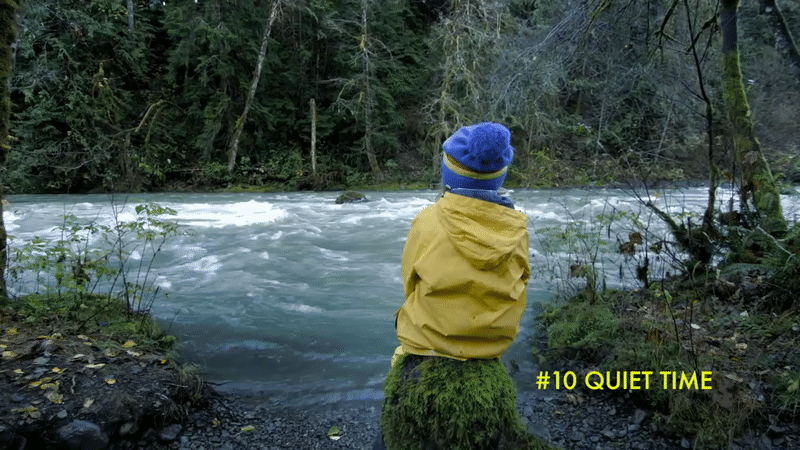The best holiday gifts often come in the most interesting packages!!
Last week we received great news around the Gila River in Southwestern New Mexico, which was named as America’s Most Endangered River in 2019. You may recall that we listed the Gila as #1 due to the threat of a major diversion that could be built on the Gila, just downstream from where the river tumbles out of the first Wilderness area designated in the United States.
The history of the proposed Gila River diversion is complicated (to put it mildly.) Basically, it was proposed as part of a federal water transaction, rooted within the Arizona Water Settlement Act, which was passed in Congress in 2004. Essentially, the Federal government pledged to provide New Mexico with around $66 million dollars to build a water supply diversion on the Gila, while at the same time providing water to the Gila River Indian Community in Arizona, through the Central Arizona Project (CAP.) A “quasi-governmental” advisory committee, called the New Mexico CAP Entity, was set up to design and build the Gila River diversion. The project would be subject to public environmental review as required by the National Environmental Policy Act (NEPA.) This “NEPA process” was led by the Department of Interior, and project proponents would have 10 years to guide the project through the NEPA process and get final permission to build the project.
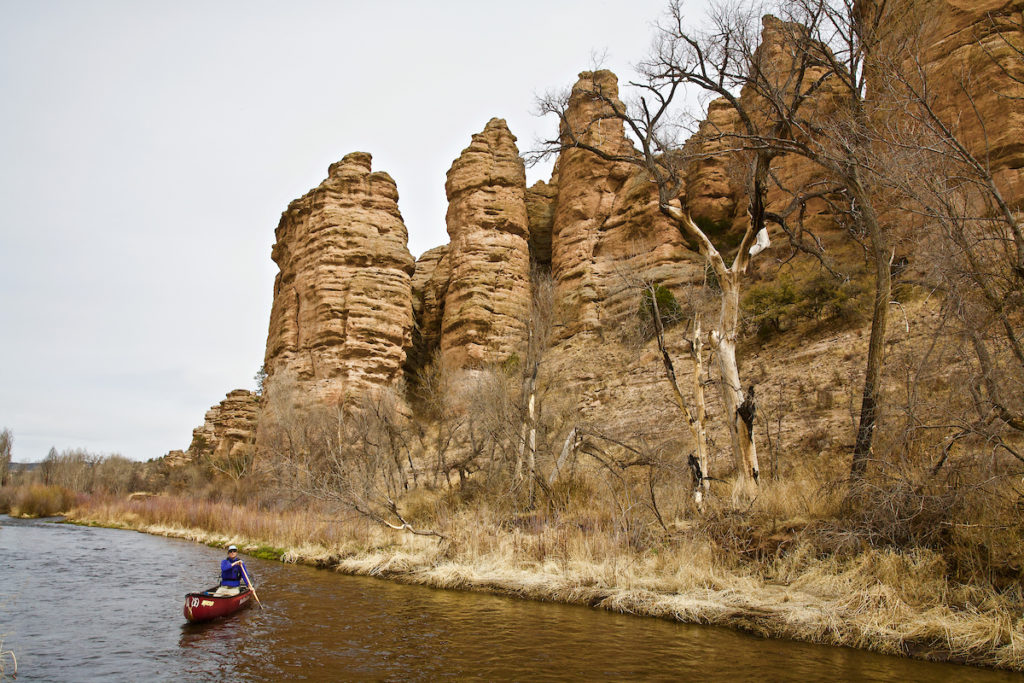
The 10-year clock expires on December 31, 2019. Over the last decade, the New Mexico CAP entity has spent somewhere around $15 million dollars in studies, design, proposals, legal fees, and other expenses, with essentially nothing to show for it. In fact, just a few months ago, a new proposal was released that would have shrunk the project down from a fairly extravagant, extensive series of diversions and reservoirs, down to just one small diversion and associated reservoir. The grandiose designs were a thing of the past.
Without being able to secure an extension from the Department of the Interior, giving the proponents more time, the New Mexico CAP Entity would lose access to the unspent federal money, and the clock on the NEPA process would run out. That is exactly what happened last week – the Department of the Interior denied New Mexico’s request for an extension.
So what’s next?
In the letter sent to the NM CAP Entity, the Department of Interior denied the extension, but left open the possibility that the project could be built, if separate funding was found to build the diversion. While that may seem like the project is “dead,” it may be unwise to call it officially dead until a final decision to pull the plug on pursuing the project is made by the state and the New Mexico CAP Entity. Indeed, these types of harmful 20th century projects are extremely difficult to permanently kill. The money to build the diversion can now be allocated to more local projects in and around Grant County, an alternative proposed in our Most Endangered Rivers of 2019.
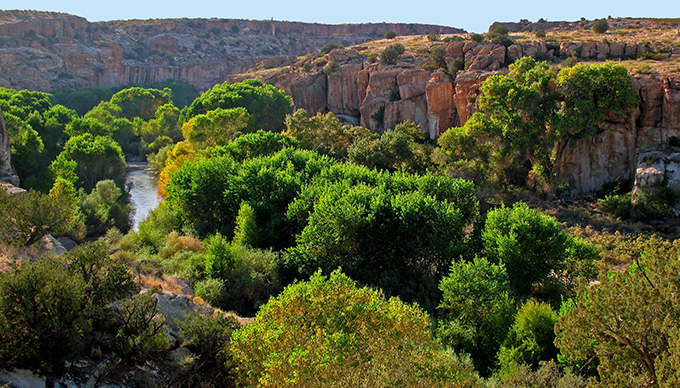
While our America’s Most Endangered Rivers of 2019 listing raised the profile and helped expand the issue with a much wider audience, the real credit for this victory should go to the local people on the ground, who have been fighting this issue for well over a decade. That includes the Gila Conservation Coalition, the Upper Gila Watershed Alliance, and the Center for Biological Diversity. They have all done years of organizing, fundraising, events, and outreach to save the Gila from this project, and they deserve lots of credit.
Credit is also due to New Mexico’s elected officials, including Governor Michelle Lujan-Grisham, and Senator Martin Heinrich. When Governor Lujan-Grisham campaigned for office, she stated in her New Mexico Water Plan that ending the efforts to build the diversion and save the Gila was one of her top priorities. Senator Heinrich, a former river guide who worked on the Gila, has been a strong proponent of protecting New Mexico’s last undammed river for many years – even before he ran for higher office.
For many, the efforts to stop the proposed diversion and save the Gila has been more than a decade of effort – blood, sweat, and tears. Now, thanks to supporters like you, we are closer than ever to securing more permanent protection for New Mexico’s last major free-flowing river. Thank you.
Water connects us across generations, cultures, geographies. And, though we may often forget, water also connects us across tables. We need water. Food, needs water. The production of one apple requires 18 gallons. A 1/3-pound hamburger is 660 gallons of water in the making. One slice of bread takes 11. (Source) Trace those vital drops back to the store, the trucks, the fields. Trace them back far enough and, almost inevitably, you will wind up at a river.
Throughout the country, producers of our food are grappling with the impacts of warming temperatures, back-to-back drought, and increasing demand on over-allocated resources, squaring up against the harsh reality that land is worthless without water.
But as is often the case, scarcity in this way also drives innovation. People who do the hard and beautiful work of growing food for their communities, and for the world, are some of the first to imagine what a new relationship to our food, and the water and rivers we need to grow it, might look like.
SONORA RISING

Water is life. And bread is a living food. In the Sonoran Desert of Tucson, Arizona, third-generation farmer Brian Wong and Don Guerra of Barrio Bread work closely with the director of Tucson Water to imagine, and realize, a sustainable circle for growing heritage, heat-tolerant wheat; producing, selling, and educating local communities about their food; and using a model of recharge and recovery to improve the long-term sustainability of a thriving city in the Sonoran desert.
LECHE Y MIEL (MILK & HONEY)

People who grow food for the nation rely deeply on water from the Lower Colorado River to fuel and feed their faith, their families, and the livelihoods they build cultivating the country’s primary source of salad. The future of America’s Most Endangered River® of 2017 is also the future of the people who live and work in Yuma, Arizona, and the need to protect it is imminent.
ALICE’S GARDEN

In Milwaukee, Venice Williams works through a community garden to reconcile a complicated relationship with the Milwaukee River. The 2-acre farm where Williams works is called Alice’s Garden, and it was a critical stop for the underground railroad. Though the Milwaukee River once provided refuge and life and nourishment, disguising the scent of freedom seekers on the run and quenching thirst, it has also been a place of segregation and divide, welcoming people with means on river paths and excluding others. Using food and the water it needs to educate and connect people, Williams builds bridges back to a tradition of growing food, and to a future where the river is as vital, and as shared, as ever.
WALT

For decades, Walt Shubin has tracked the weather, rainfall, and the level of his well on his raisin farm near Fresno, California. Between 2005 and 2014, that well has dropped 19 feet. In the final nine months of 2014, it dropped another 19 feet. Walking the dry river banks of the once “mighty San Joaquin”, Walt contemplates a future of farming without the aquifer, and the free-flowing river so critical to its existence.
A RIVER’S RECKONING
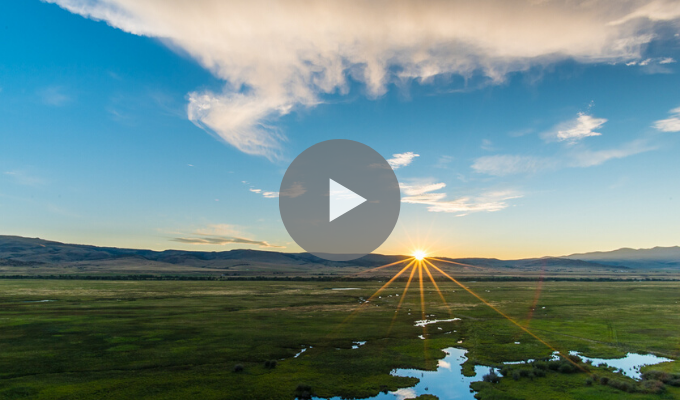
Paul Bruchez was guiding a fishing trip when the river literally dropped before his eyes. And while his clients were on his mind, it was his families’ 5th generation roots in agriculture and their dependence on the river, that came into sharp focus. Water weaves its way through the Bruchez family, and the Upper Colorado River they rely on is the pulse and breath of the valley they call home. But changes in conservation weren’t happening fast enough, and the problem of water shortages isn’t one that the Bruchez family could solve alone—it spanned the miles-long reach of the river. This realization spawns a unique coming together of producers working to redefine the relationship between the river, and the food families living along its banks work to produce.
***
Through these and other films, American Rivers works to find and share the stories that dissolve barriers and bring us together to break bread, if we’re lucky, at the river’s edge.
Page Buono is a creative writer working with the Colorado Basin team to tell important stories about rivers across the Southwest. She has a B.A. in Environmental Journalism and Spanish from Western Washington University and an MFA in nonfiction writing from the University of Arizona.
The Pacific Northwest is one of the most wonderful places in the world. We want to keep it that way. At American Rivers, we’re committed to protecting and strengthening what makes our region special, including:
- Abundant wild salmon and steelhead filling our rivers, supporting communities and livelihoods
- Clean, affordable energy powering our homes and businesses
- Thriving agriculture driving a strong economy
If we want all of this for our future, we must come together around shared values: the desire for continued prosperity and growth, love of place, respect for our neighbors up and downstream, and big, inspired thinking that has always defined our region.
Washington Governor Jay Inslee today released a draft report detailing findings from the Lower Snake River Dams Stakeholder Process.
Here’s why this report matters for rivers, people and salmon in the Northwest, and what comes next.
What is the Lower Snake River Dams Stakeholder Process?
The process has engaged local, state, tribal and federal leaders and stakeholders around addressing issues associated with the possible removal of the four dams on the lower Snake River in eastern Washington in order to recover the Chinook and other salmon populations that serve as a vital food source for Southern Resident orcas. Salmon are integral to the region’s indigenous people, and support the recreation and commercial fishing industry.
What does the report say?
The draft report doesn’t recommend removing or keeping the four lower Snake dams. It summarizes the beliefs and concerns of those on both sides of the issue. Importantly, it emphasizes opportunities to increase understanding – areas where we need more information and dialogue, in order to come to solutions that move everyone forward together.
Why does this report matter?
The people of the Northwest want a future with clean energy, thriving agriculture, and salmon runs that honor tribal treaty rights and support strong communities. These opportunities are all connected – we can’t address one without addressing them all. Governor Inslee’s report is a step toward the creative thinking and problem solving we need to do as a region to understand a path forward.
For example, if the lower Snake dams are removed, how will we replace the benefits the dams currently provide? What kinds of investments will be needed in energy, irrigation and transportation infrastructure? How can we protect and strengthen local economies?
How can I make my voice heard?
The public comment period runs December 20 to January 24. You can fill out the online questionnaire here. You can also attend a public workshop to learn more (January 7 in Clarkston, January 9 in Vancouver, January 13 in Tri-Cities). Visit the stakeholder process homepage for workshop details and additional information.
What needs to happen next?
When it comes to Snake River salmon recovery, communities have been stuck in a cycle of conflict and uncertainty for decades. Governor Inslee’s report has helped spur a conversation that can move us forward. Now, we need the Northwest’s elected leaders to bring the different sides together to resolve conflicts and help us plan for the future. You can encourage your member of Congress to be part of this important effort.
The holiday season is upon us, and between the deep-fried turkey disaster, the sprigs of plastic mistletoe hanging about, and the cat knocking down the Christmas tree, ‘tis the season to look back upon the year that was, and get excited for the new year ahead.
In Arizona, a literal haboob of water-related action happened over the course of the year. We faced, and then dodged, certain water shortages that could have had a significant impact on the lives of literally everyone who calls the Grand Canyon state home. With a plentiful snowpack in the mountains of Colorado, Utah, and Wyoming, water managers in Arizona and California were able to reduce the state’s use, while keeping Lake Mead out of certain jeopardy. Had this not happened, it could have wreaked havoc to Arizona residents, the state’s agriculture and recreation economy, and the health and viability of the Colorado River.
In the spring, Arizona then passed state legislation to authorize entering what is called a Drought Contingency Plan – defining voluntary cutbacks when Lake Mead falls below a comfortable level. This Plan helps Arizona voluntarily address shortages even before existing Federal rules would kick in. Arizona also joined California and Nevada in getting a broader “Lower Basin” Drought Contingency Plan passed, which was presented, along with an “Upper Basin” version supported by Colorado, New Mexico, Utah, and Wyoming, to the Senate, then ultimately to President Trump, who signed these pieces of legislation into law.
This was truly a bi-partisan effort, with state legislators, Arizona’s Senators, and the President coming together to address the complex and somewhat dire situation that could have presented itself if all parties had not had the fortitude to put aside political differences and finish the deal. By working together, the Arizona way, crisis was literally averted.
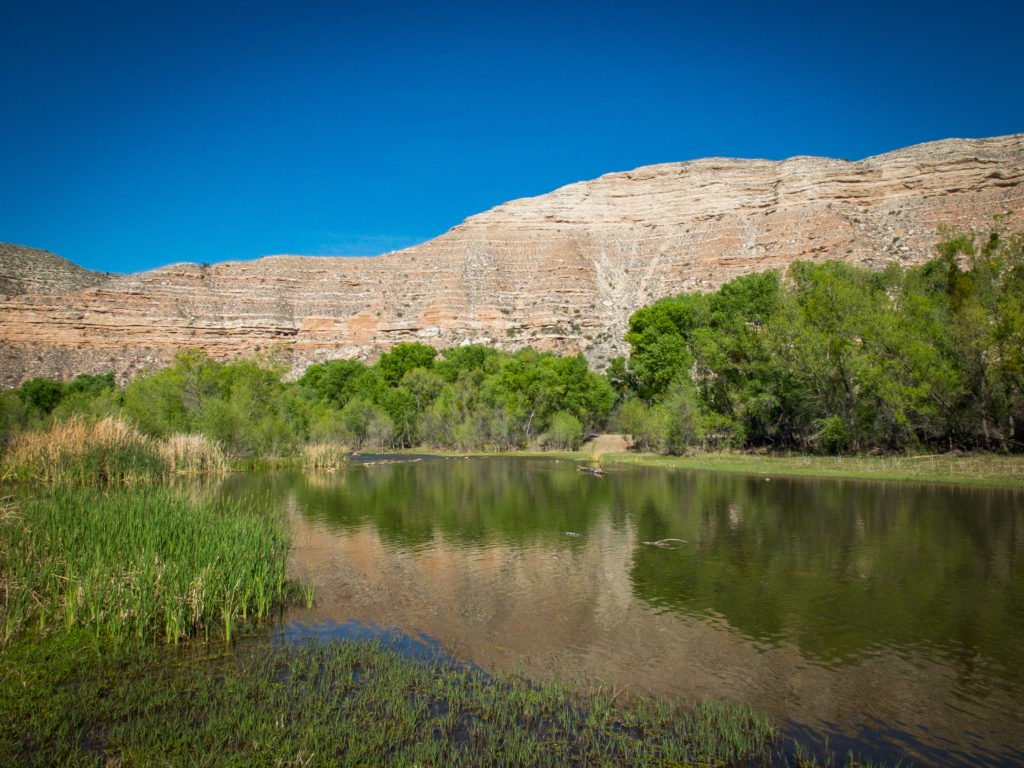
But that in no way means we are done. As part of the Water for Arizona Coalition – a collaborative assembly of water conservation-oriented groups, American Rivers and our partners are excited for what’s ahead.
As you may have seen in a recent article by Ian James, clearly the issue of groundwater depletion and how rural Arizona is being eyed for greater extraction of literally ancient water sources, many that can never recover in our lifetimes without both protection, and restoration, is now grabbing headlines. We also want to be sure that the advances we all made by the passage of the Drought Contingency Plans are put into practice, and that Arizona, and our Lower Basin partners, do what we can to avoid deep mandatory cutbacks if shortage were to occur due to falling water levels in Lake Mead. We may hope for high-country snowpack as plentiful as last year, but we should plan for the return of lingering drought. Lastly, we are excited to be working on efforts to protect Arizona’s remaining flowing rivers and developing flexible tools to support those who want to conserve water and leave it in the rivers. Over a third of Arizona’s perennial rivers have already dried up, and it will be important that we double down on collaboration, conservation, and creative thinking so that we can keep Arizona’s remining rivers healthy and flowing – now and into the future.
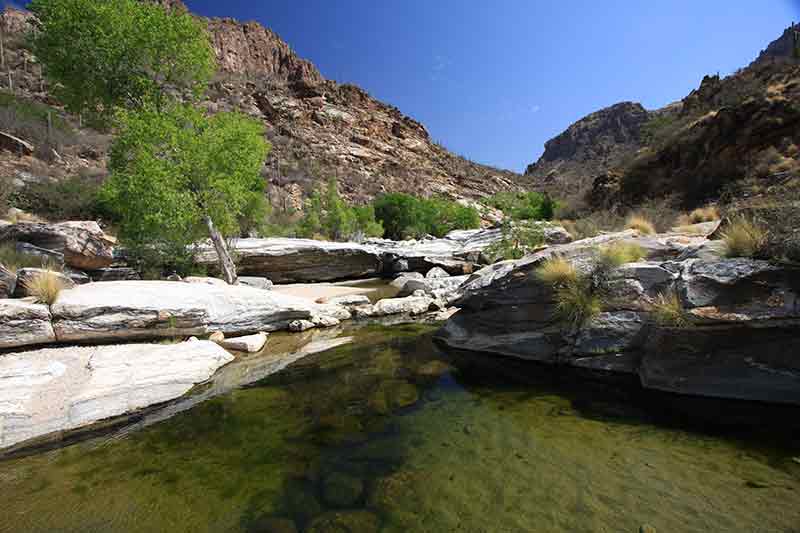
Ultimately, we need to learn how to live with less water. The Water for Arizona Coalition is guided by four main principles. First, Arizona needs to find creative, collaborative, and conservation-minded ways to bridge the gap between declining future supplies and projected demands. Second, we want to be mindful of the health and sustainability of the Colorado River, supporting thoughtful ways to both preserve the viability of the river, while also supporting the communities along the river, as well as the millions of people in central Arizona that also depend on its water. Aside from the Colorado River supply, we also want to be sure to not retreat from the advances in protecting Arizona’s groundwater, and the foresight from the 1980 Groundwater Management Act which has served as a vehicle to sustain and rebuild Arizona’s critical aquifers across much of the state. Lastly, we strive to educate and elevate the issue of water, and the dependence of everyone who lives in Arizona upon it, about the gap between a dwindling supply of water, and the oversize use of water, in one of the fastest growing states in the nation.
2019 was a challenging, but exciting year. 2020 is shaping up to be just as pivotal for the long-term sustainability of our state, and the entire Southwest. American Rivers is excited to have you along for the ride. To the year ahead – cheers!!
Oregon’s Senior U.S. Senator Ron Wyden has issued an unprecedented public call to action to protect more of the best rivers across the state as Wild and Scenic. He has initiated an open public process for Oregonians to nominate rivers that we would like to see him protect that are outstanding for their recreation, fish and wildlife habitat, or because they provide clean water. From now until January 20th, 2020 he is seeking our input on which rivers he should protect. That’s right, he wants us to help him protect rivers.
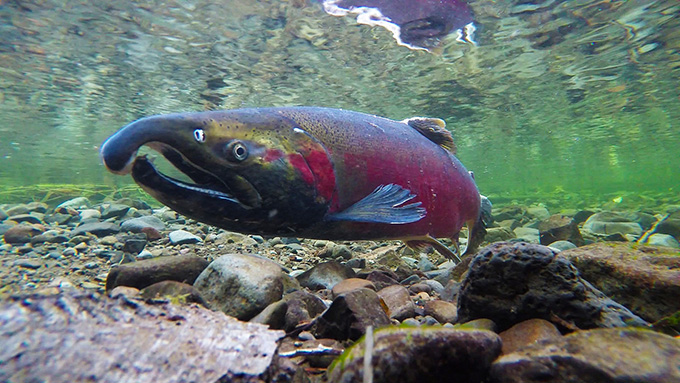
Land Management Oregon and Washington
Clearly not your typical politician, #WildandScenicSenator has long been an advocate for protection of the state’s best rivers. Since first coming to the U.S. House in the 1980’s he has championed more Wild and Scenic Rivers designations than any other member of Congress for his home state—protecting 1,984 miles of rivers and over 600,000 acres of riverside land. We have Senator Wyden to thank for preserving so many of Oregon’s great waterways: the whitewater boating on the Deschutes; the drinking water flowing out of the Bull Run watershed that serves the City of Portland; and the great salmon and steelhead fishing on the Rogue.
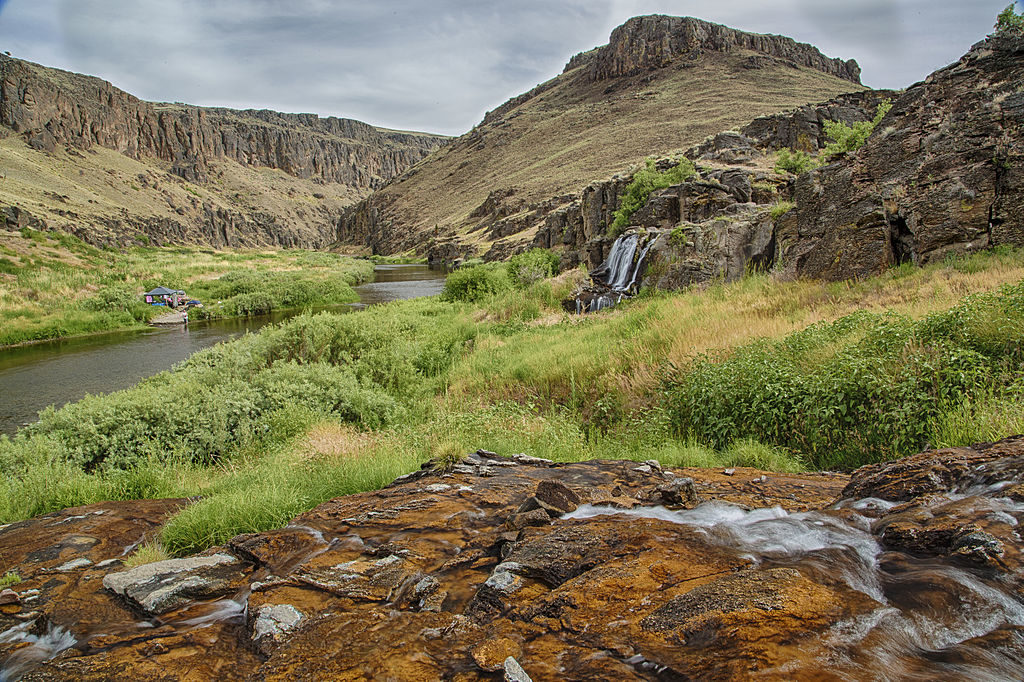
And while we have a lot to be thankful for, after all Oregon has more permanently protected Wild and Scenic Rivers than any other state except Alaska, this adds up to only 2% of the river miles in the Beaver State. We still have a lot of work to do and thankfully Senator is leading the charge to help, even pledging to “beat Alaska” for the state for the most protected Wild and Scenic Rivers.
Senator Wyden is giving us a voice, a direct vote, in the future of our rivers. I like to think of his call to action as river democracy in action. This simply doesn’t happen very often so let’s seize this once in a generation opportunity and flood him with good ideas. Over the next two months I will be highlighting some of Oregon’s best rivers that deserve protection, but in the mean time email Senator Wyden to vote for your favorite river and thank him for this incredible opportunity. You can email him at: rivers@wyden.senate.gov
This is a guest blog by Ethan Duvall
Salmon spawning rivers of the Pacific Northwest are home to some of the largest and most spectacular Bald Eagle congregations in North America. Each winter, hundreds to thousands of eagles migrate to these rivers from breeding areas as far north as the Yukon Territory, brought together for one main reason: to feed on post-spawning chum salmon carcasses.
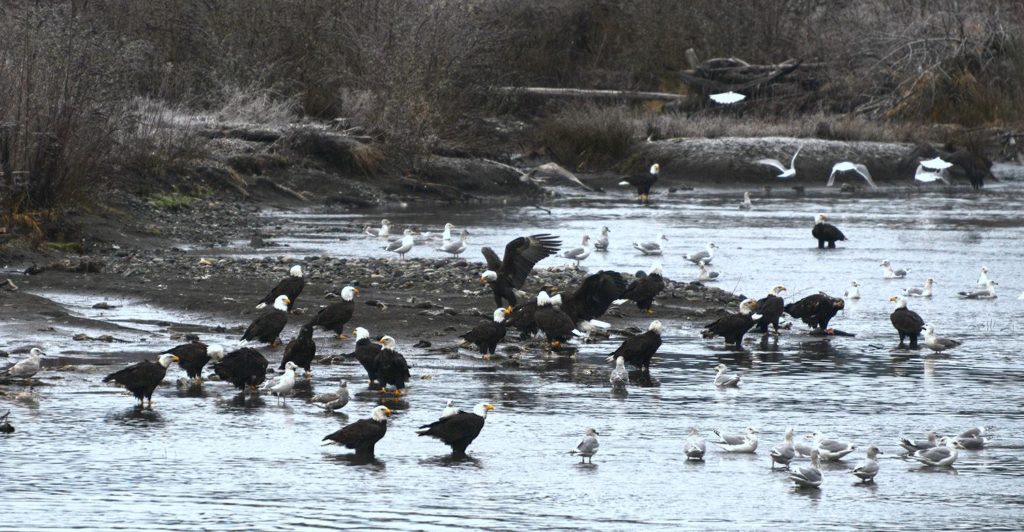
After swimming long distances upstream from the Pacific Ocean and through the open waters of Puget Sound, chum salmon complete their life cycle by spawning, laying eggs, and dying within the upper river channels and tributaries, in their natal water. Freshly deceased salmon carcasses wash onto river banks and gravel bars along the river, providing an abundant and reliable food source for eagles and other wildlife during the cold winter months. Although this amazing wildlife phenomenon has occurred for as long as humans have observed, humans have issued many threats to salmon populations in this region, jeopardizing the eagles that depend on their carcasses.
[su_image_carousel source=”media: 52947,52948,52951,52949,52950,52958,52959,52965″ slides_style=”minimal” crop=”none” dots=”no” link=”none” captions=”yes”]
The Skagit River, draining a 1.7 million-acre area of the Cascade Mountain Range, has historically hosted the largest eagle congregations within Washington state. However, a recent publication1 by the North Cascades Institute highlighted an unfortunate reality: the abundance of over-wintering eagles has dramatically declined on the Skagit River over the last two – three decades. These declines were correlated to an overall reduction in carcass availability, driven by steady declines in salmon runs, impacts of climate change, and other anthropogenic stressors. Although much of the Skagit River received proper protection under the Wild and Scenic Rivers Act in 1978, its designation was after the construction of three large dams between 1926-1930, which have been restricting fish passage, altering natural flow regimes, and obstructing downstream sediment deposition for almost a century.

As the carrying capacity for eagles continues to decline on the Skagit River, many have begun to worry about the sustained presence of eagle congregations on rivers in Washington. Eagles are highly adaptive, generally concentrating in areas where food is most abundant and easily accessible. Some scientists presume that eagles are now utilizing other rivers more intensely in response to changes in resource availability. Given these speculations, I became curious about the condition of bald eagle congregations on another historically productive salmon spawning river: the Nooksack River.
The Nooksack River, draining a 500,000-acre area of the Cascade Mountain Range near Mt. Baker, is highly admired for its pristine habitat, recreational use, and the clean water it provides to native tribes and heritage farm towns. Unlike the Skagit, as well as many other rivers in Washington, the Nooksack remains free-flowing and absent of any major dams, allowing for natural fluvial processes and soon-to-be unimpeded fish passage. Despite being a much smaller river than the Skagit, the Nooksack has supported a greater chum salmon run than the Skagit River for five of the last eight years.
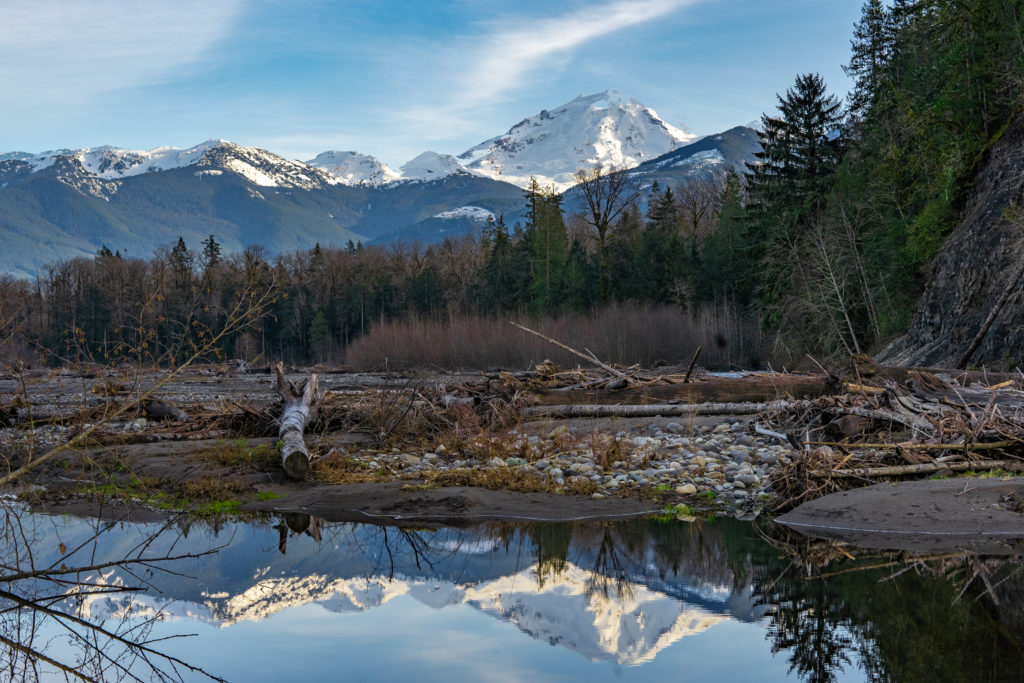
Although the Nooksack is generally acknowledged for its eagle congregations, its attention has been largely overshadowed by that of the more famous Skagit River. The most recent studies assessing eagle abundance on the Nooksack precede the 1980s, providing no real insight as to how populations have changed over time or responded to recorded declines on other rivers. For this reason, I set out to assess the current abundance and distribution of bald eagles on the Nooksack River. During the winter of 2018-19, I conducted weekly bald eagle surveys along a 19-mile stretch of the river between the towns of Deming and Maple Falls, Wash. Among the many awestriking sights and sounds that I observed throughout my study, what I recorded was truly inspiriting.
Over 650 eagles were detected utilizing the Nooksack River in late December, an abundance over six times greater than recorded between 1974-1977, and a density over three times greater than recorded on the Skagit River in the same year. Eagles filled the trees along the Nooksack River, concentrating among the many salmon spawning tributaries and sloughs. Eagles were spread across the river banks and gravel bars, feeding on the rich salmon carcasses the river had gifted them. The scene was miraculous, truly representing one of North America’s most amazing wildlife phenomena.
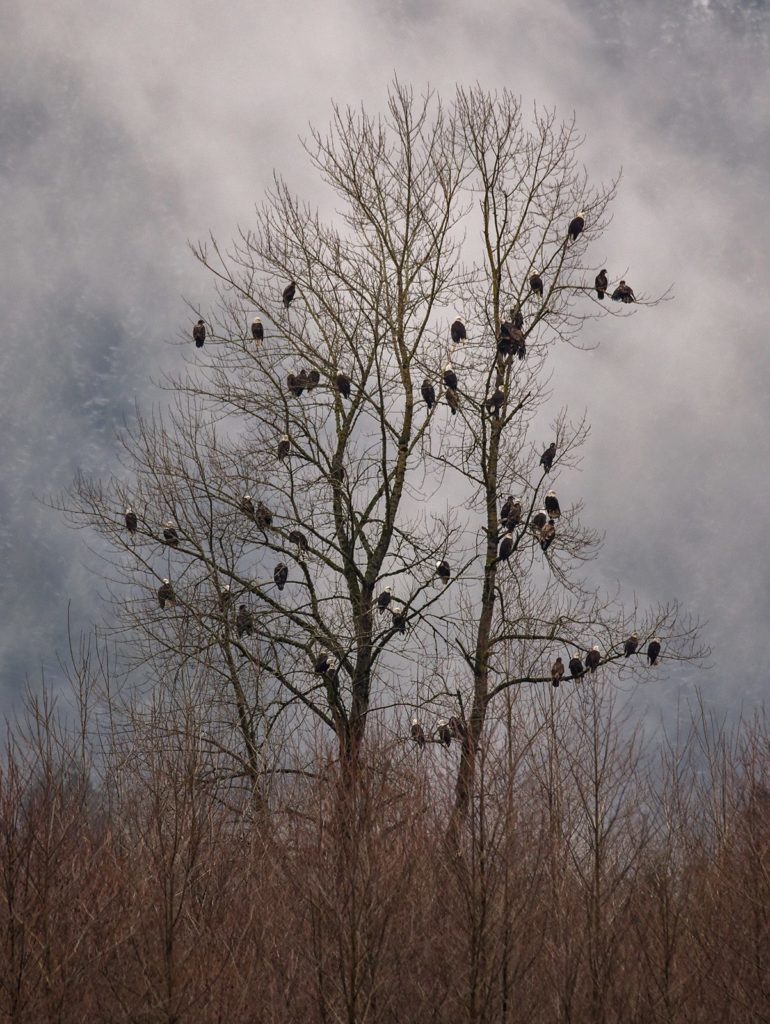
In spite of its rare beauty and clear importance for both people and wildlife, the majority of this vital river system remains deprived of even the most fundamental protection. Many of the threats endangering eagle congregations on other rivers, such as the Skagit, still remain a threat to the Nooksack; some 40 hydroelectric dams have been proposed for various sites on the Nooksack River since the 1970s, and the legacy of logging impacts and other human development remains along portions of the river.
In the interest of preserving the river’s value, the Nooksack River Wild and Scenic campaign is currently working toward introduction of legislation that will help protect the Nooksack River and its amazing wildlife. The Wild and Scenic Rivers Act designation would ensure that the river’s “outstandingly remarkable values,” including its prosperous chum salmon runs and extraordinary eagle congregations, are protected and enhanced in the future. The legislation would prevent any new dams or other projects that would degrade the river’s rare natural character and healthy flows.
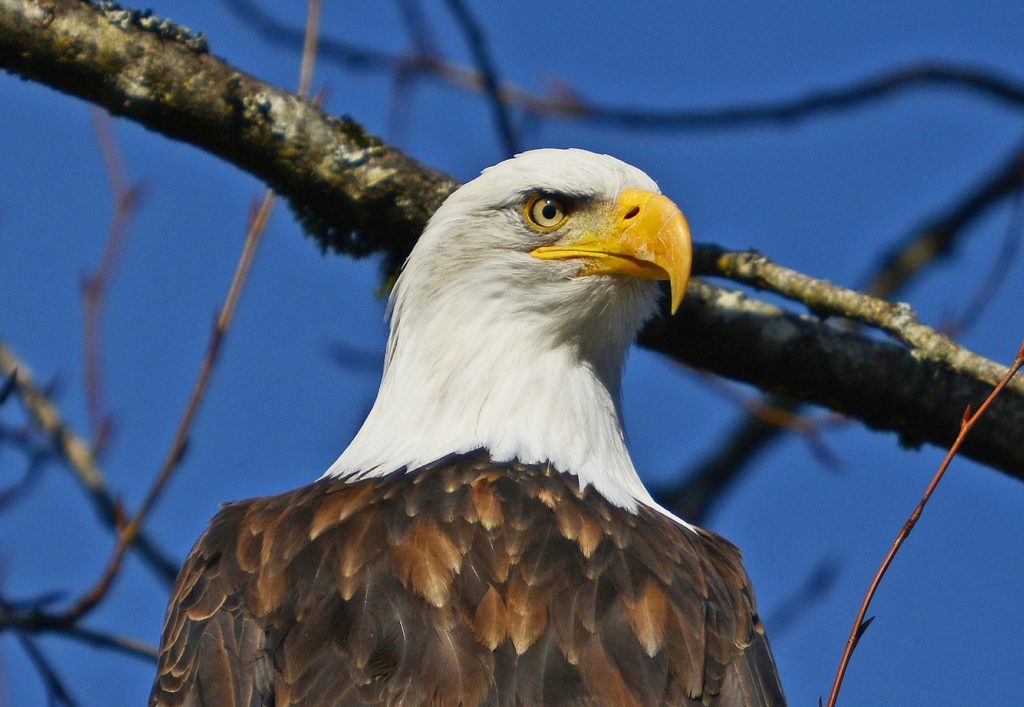
As the carrying capacity for eagles declines on other rivers in the Pacific Northwest, the Nooksack River continues to become an increasingly rare and important place of refuge for eagles during the winter. By protecting the Nooksack River under the Wild and Scenic Rivers Act, we can help ensure that this beautiful river will continue to support the extraordinary salmon runs and bald eagles congregations that characterize the Pacific Northwest.
Sign the petition and learn more about the Nooksack River Wild and Scenic Campaign »
References
- Rubenstein, M., Christophersen, R., & Ransom, J. (2019). Trophic implications of a phenological paradigm shift: Bald eagles and salmon in a changing climate. Journal of Applied Ecology, 56(3), 769-778.
This blog was written by Shanyn Viars and Jeff Odefey
It’s no secret severe storms are becoming more frequent and historic flooding events more common. For cities, managing rain and preventing floods is a routine part of urban maintenance. As cities continue to grow, the amount of rooftops, driveways and other hard surfaces increases across our landscape. The result is more rain flowing through our streets, more stormwater to manage. Municipalities have always borne the responsibility of managing stormwater; protecting our communities from flooding and reducing adverse impacts to our water resources. Although important, it is a costly endeavor and funds for managing stormwater are not always a priority as limited resources are directed to address other community challenges.
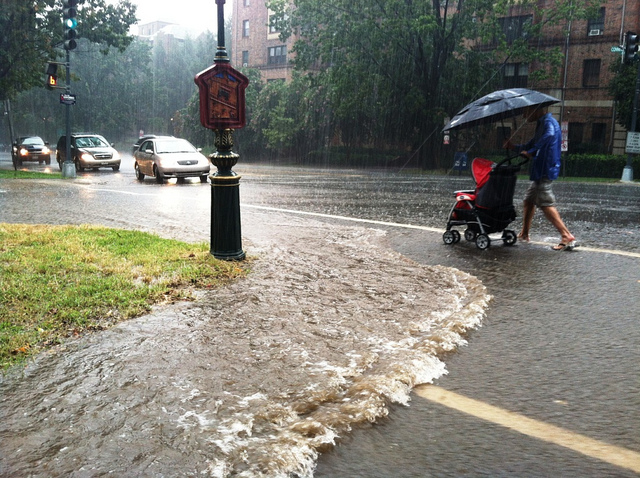
The burden for municipalities continues to rise, yet private property owners are the highest contributors to stormwater costs. Stormwater runoff mostly comes from hard surfaces on privately-owned land – driveways, parking lots, rooftops. Stormwater contributors include shopping malls and big box stores with large parking lots, factories and lively urban district with blocks of buildings, residential neighborhoods and apartment communities with many rooftops and driveways – basically the fabric of urban life.
Green infrastructure is one solution that cities are adopting to better manage stormwater by mimicking the natural water cycle, but land (and good soil) also needs to be available. Therefore, we need to explore sustainable solutions that encourage private property owners to participate in protecting their cities from flooding and reduce their impact to water resources.
Stormwater regulations and permits are limited, contributing little to the overall cost of managing rain events in urban areas and offering minimal protections to natural water resources.
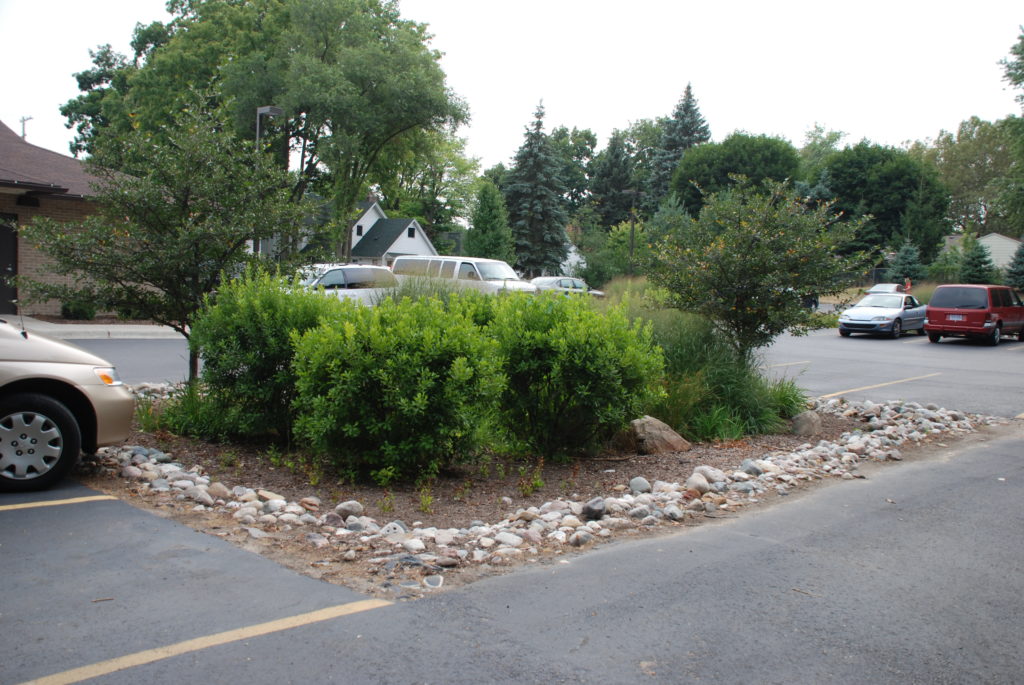
Photo by Patricia Pennell
Compliance with stormwater permits can be costly to cities and property owners but is crucially important to our efforts to protect and restore urban rivers and streams. To protect our cities (and business) we need to redefine stormwater management by encouraging the private sector to invest in green infrastructure on their properties. Effective encouragement may come in the form of incentives that reduce the cost of installing green infrastructure and create economic rewards for effective projects.
With the support of the Great Lakes Protection Fund, Stormwater Currency and the City of Grand Rapids explored a market-based approach that creates incentivizes for private property owners to choose green infrastructure approaches for managing their stormwater. We sought solutions that harness the economic advantages of a market to fund green infrastructure on private property, reducing costs to the developers and the City. Our solution, Stormwater Credit Trading, allows private property owners who need to comply with stormwater regulations to “purchase” volume “credits” from other property owners that are not subjected to or have exceeded their requirements. This market-based approach addresses the need for private property owners to contribute to the overall cost of managing stormwater while rewarding others for protecting their communities and environment. A benefit of a credit trading market is the opportunity it can provide to distribute funds from green infrastructure investments across neighborhoods and address stormwater challenges for communities that have historically been neglected. For those that are considering sustainable solutions to address stormwater in your communities, we developed a handy guide, Establishing a Stormwater Volume Credit Trading Program.
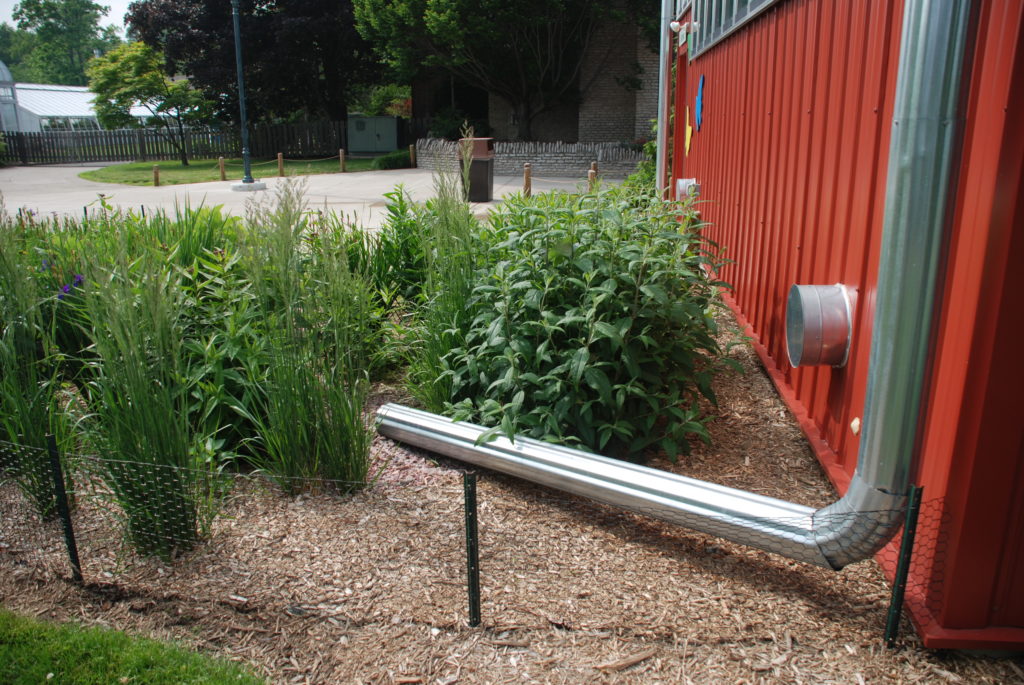
We’re having a great time exploring sustainable solutions with Grand Rapids Environmental Services Department and partnering with local organizations to design a program that builds on private-public partnerships using market-based approaches.
Stormwater credit trading not only provides economic benefits by reducing the cost on municipalities to reduce and manage stormwater but it advances the implementation of green infrastructure across the city. Ideally, the market will encourage a more equitable and efficient distribution of green infrastructure across an urban landscape to create greener, more livable cities and cleaner rivers.
For more information on the market-based approaches by Stormwater Currency (a collaboration of American Rivers, Corona Environmental Consulting and the Water Environmental Federation), please visit stormwatercurrency.com.
For more information on stormwater credit trading please contact Jeff Odefey, Director, Clean water Supply, American Rivers at jodefey@americanrivers.org.
If your niece says: “Have you seen Frozen 2?”
You can say: “Totally! The river is the source of memory and power – and removing the dam restores balance to the land and people. Did you know that American Rivers and its partners have removed record numbers of dams over the past two years to restore healthy rivers?”
If your grandfather says: “Flooding in the Midwest was really bad this year, we need to raise those levees!”
You can say: “Actually, the best way to protect homes and businesses is by giving rivers room. We need to let floodwaters spread out and keep people out of harm’s way.”
If your uncle says: “Can you help me wash these dishes?”

You can say: “Can you believe more than 2 million Americans don’t have clean water in their homes? Do you know where your water comes from?”
If your sister says: “I want to get everyone meaningful gifts but nobody needs more junk.”
You can say: “A membership to American Rivers makes a great gift!”
If your cousin says: “We should be fighting climate change by building more hydropower dams.”
You can say: “Dude, dams can kill rivers. There’s a role for hydro but all the best spots for dams in our country were developed long ago. We need to focus on investing in conservation, efficiency and renewables.”
If your aunt says: “My New Year’s resolution is to volunteer more.”
You can say: “Awesome. You can pick up trash along your local stream with National River Cleanup®!”
If your brother says: “The news is so depressing.”
You can say: “It’s not all bad! American Rivers and its partners protected more than 600 miles of wild, pristine, free-flowing rivers this year! And, cities from Atlanta to Milwaukee to Tucson are revolutionizing the way they use water in equitable, cost-effective ways!”
If that same brother says: “Yeah, but the Trump administration is gutting the bedrock protections we rely on for the environment and public health.”
You can say: “I know. Pass the wine. But seriously, find out how we’re defending rivers.”
If your kids say: “Winter break is boring, there’s nothing to do.”
You can say: “Put your jackets on. We’re going to the river.”
*** Happy holidays! ***
“The past is not what it seems. A wrong demands to be righted.” An image of a massive dam appears on the screen, and that’s when you know: Frozen 2 rocks. It is a river movie, a rallying cry for the environment, a story that couldn’t have come at a better time. High five to Disney, for making a movie that celebrates free rivers.
In the movie, the problems begin when the king gives the native people a dam to “strengthen their waters” as a “gift of peace.” But the dam wasn’t a gift, it was a trick.

The dam becomes the root of all problems, leading to fighting and angry spirits. A mist engulfs the forest, locking everyone out.
Elsa and Anna, hearing this story, ask their mother if the forest will wake up. “Only the river knows,” she tells them. The river is the source of memory and knowledge. It holds the answers to the past, what we’re all a part of.

Elsa hears a call from the forest and follows the voice. She wants to find the truth. She learns about the harm her grandfather caused to the native Northuldra people. She sees a vision from the past: A Northuldra man is talking about how the dam has hurt the forest and his people.
Her grandfather says patronizingly, “Let’s sit down and have some tea.”

The river is the source of truth, power, magic. Anna realizes they need to break the dam to free the forest and save Arendelle.
Your heart will soar as Kristoff gallops up on Sven, the reindeer, and tells Anna, “I’m here! What do you need?”
“To get to the dam!” she shouts.
You will cheer as the earth giants hurl their boulders. [Note: will you ever float a river again and not see the canyon walls as the bodies of giants that could come to life?]

Once the river is flowing freely again, all is well. Balance and justice are restored.
This is a story we need right now, as our world is sorely out of balance. We need more stories that celebrate the natural world and our place in it. We need more stories about listening to nature and each other.
Here’s hoping Frozen 2 inspires a new generation of river protectors.

“Rivers have given me my life,” Georgia native Claude Terry said in an interview in 2016, as he approached his 80th birthday. As one of the founders of American Rivers, it’s also true that he gave life to rivers.
Claude passed away last week, leaving a remarkable legacy.
In the 1960s and ‘70s, Claude and other local citizens successfully fought to protect Atlanta’s Chattahoochee River from polluted runoff, sewage and poorly planned development, culminating in its designation as a National Recreation Area.
“I find myself happiest when the music of rapids is playing.”
– Claude Terry
Claude’s passion also made him instrumental in protecting wild rivers such as Georgia’s Chattooga. He served as actor Jon Voight’s stunt double in the 1972 movie Deliverance, which was filmed on the Chattooga. He introduced then-governor Jimmy Carter to the river and helped ensure its eventual designation as a Wild and Scenic River. Then, using canoes and other equipment purchased from Warner Brothers following the filming of Deliverance, Claude opened the outfitting company Southeastern Expeditions.
Claude helped tell this story in our film, The Wild President, produced in 2017.
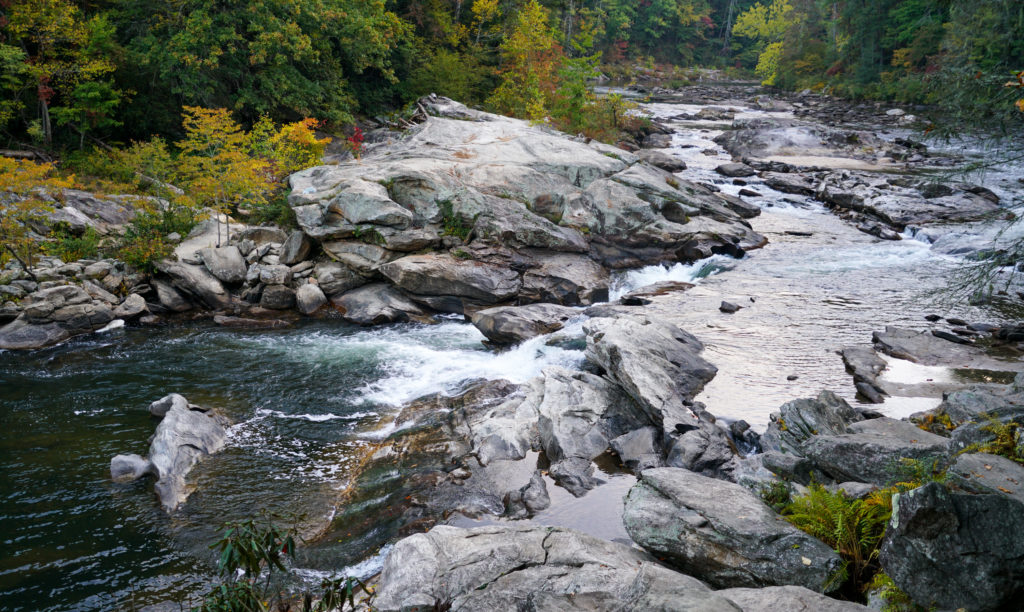
Recognizing a need for a national organization dedicated to safeguarding rivers, Claude and other river enthusiasts founded American Rivers in 1973. They gathered at a meeting in Denver, and Claude tossed a twenty dollar bill on the table. Years later, after American Rivers had grown into an organization with a $17-million dollar annual budget, Claude quipped, “Not a bad return on investment, huh?”
“Claude is a river hero, one of the great champions of the conservation movement,” says American Rivers President Bob Irvin.
“He was an inspiration and provided wise advice to me and other American Rivers staff. He supported American Rivers throughout our 47 years of existence. In recognition of his continued service to American Rivers, he was named a Director Emeritus in 2018,” Irvin said.
“We can all benefit from Claude’s example of working tirelessly for clean water and wild places, while also remembering to get out and enjoy the rivers we love.”
As you may have recently seen, a Phoenix-based developer has proposed to build a pumped hydropower storage project, consisting of two dams and a whole network of related infrastructure, in one of the most culturally relevant areas of the country. Because this proposal is related to hydropower, the relevant federal agency is the Federal Energy Regulatory Commission, or FERC, which has a unique and more formal style than other agencies. In short, the developer has submitted a filing, like in a legal case, which holds a place in line at that location, but in no way gives any authorization to actually build anything. In fact, the developer is explicitly given instruction about things that this permit application DOES NOT give them permission to do – including even visiting the proposed site for planning purposes.
Under the FERC rules, parties can file official comments, or “intervene” in the case, placing us in a formal setting as parties in the application process.
On Friday, November 15th, American Rivers officially intervened in the case against the proposal. But what did we say?? What points did we make to oppose this project? Here is a brief overview of what we said in our filing –
1) The application does not identify any sources of funding. In fact, even in their own filing the developer states that no funding sources have yet been identified. It’s like saying you are going to buy that fancy house on the corner, but you have not even spoken with the bank yet to see if they would loan you the money.
2) The application does not show adequate consideration of tribal interests. Basically, the developer is aware that the project would be cited on Navajo tribal land, but does not acknowledge the cultural relevance to any other tribe – including the Hopi (most notably,) the Paiute, or the many other Puebloan people who consider the Grand Canyon as sacred. The blatant lack of awareness about how sensitive this area is to so many people, tribal or otherwise, is shocking to say the least.
3) The application does not show adequate consideration of listed species. The developer does not identify any concern about the Humpback Chub, an endangered fish species that was federally listed in 1967 and has been the focus of a major recovery effort in the Little Colorado River and beyond for decades. One of the two dams that would be built under this proposal would be smack dab in the middle of the Little Colorado River, ground zero for Humpback Chub recovery efforts.
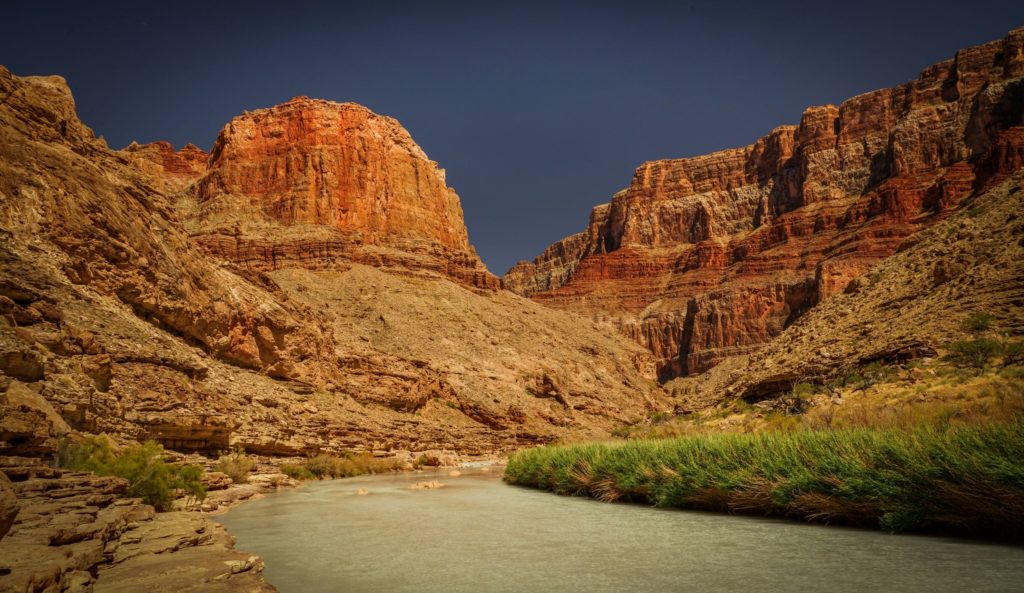
While this may seem like a fairly small list, the ramifications of it are wide-reaching. And make no mistake about it, while American Rivers has filed our own intervention, there are many other partner organizations and other stakeholders who have filed as well. Like the Hopi and Hualapai Nations, the Department of Interior, Arizona Game & Fish, and partner conservation organizations like the Grand Canyon Trust and National Parks Conservation Association.
This project is clearly a really bad idea – one that likely will go nowhere. American Rivers will be watching this one closely, and rest assured that if anything does come of it, we will be there to stand firmly in defense of the Grand Canyon and those who revere its iconic nature, cultural significance, and biological importance.
The sound of the vibrator on the track hoe pulling sheet piles out of Congaree Creek only lasted one day as the US Fish and Wildlife Service Aquatic Habitat Restoration Team removed the dam on a beautiful day in May 2019.
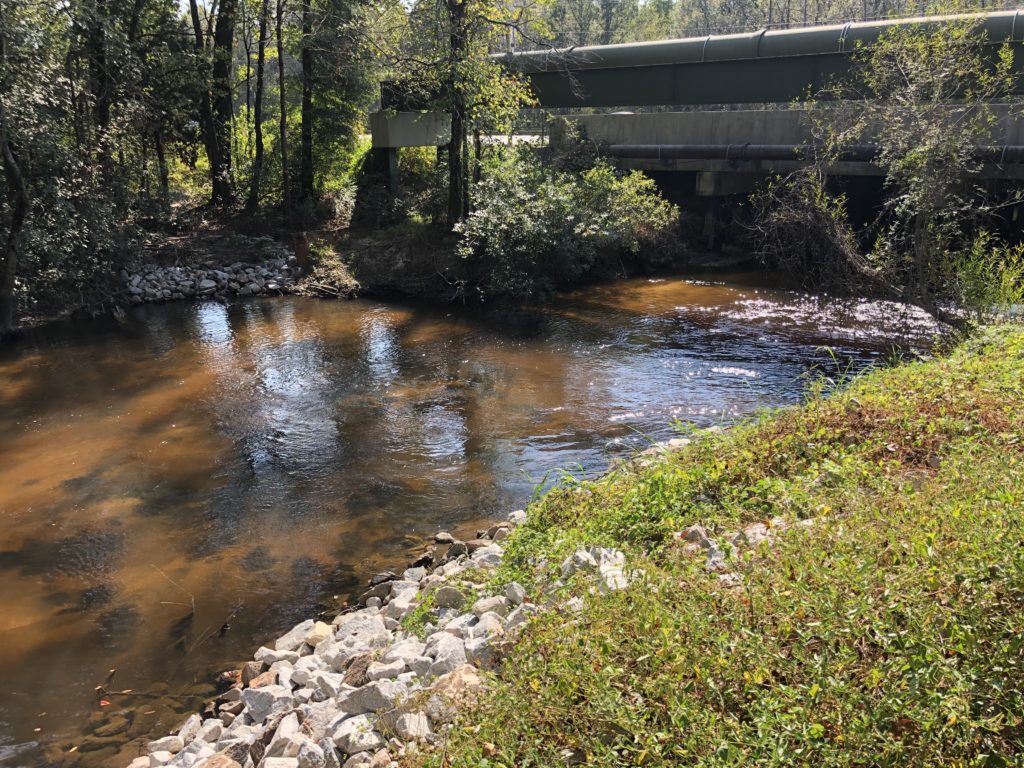
removal | Photo by Gerrit Jobsis
American Rivers partnered with the Congaree Riverkeeper, the South Carolina Department of Natural Resources, the City of Cayce, and the US Fish and Wildlife Service on this successful dam removal project.
About 15 feet high and 40 feet across, this outdated, relic dam created a dangerous hydraulic current at the start of a canoe trail. Now ten miles of mainstem Congaree Creek are reconnected which supports paddlers and aquatic life like herring, shiners, and darters alike who need access to different parts of the stream.
Many dams like the Congaree Creek dam have outlived their useful life, and dam removal is often the most economical option compared to repair. At least 82 dams were removed in 2018 restoring more than 1,230 miles of stream which brings the grand total of dams removed in the US to over 1,600!
Congaree Creek in Cayce, SC, is now flowing freely now thanks to the efforts of a strong partnership to remove a dam. Check out this short film about this dam removal.








